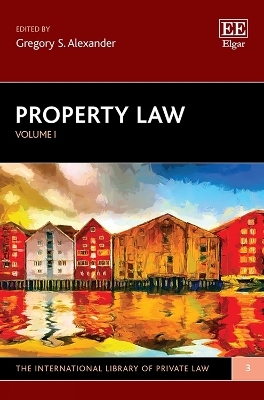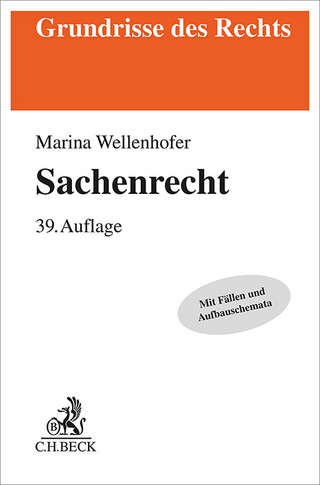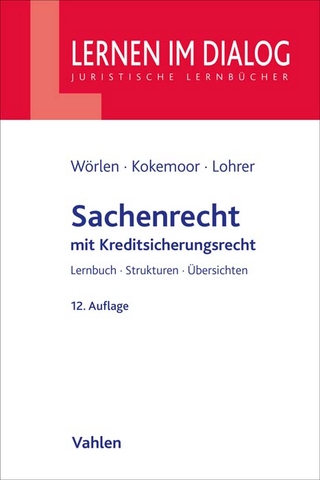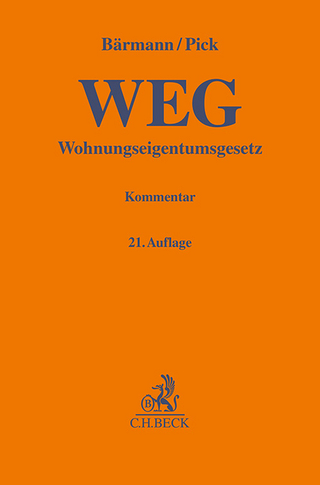
Property Law
Edward Elgar Publishing Ltd (Verlag)
978-1-78643-684-9 (ISBN)
Edited by Gregory S. Alexander, A. Robert Noll Professor of Law, Emeritus, Cornell University, US
Contents:
Volume I
Acknowledgements vii
Introduction Gregory S. Alexander ix
PART I CONCEPTUAL MATTERS: STRUCTURING OWNERSHIP
1. William Blackstone (1979 [1765–1769]), ‘The Rights’ in
Commentaries on the Laws of England, Volume II, Chicago, IL:
University of Chicago Press, 2 2
2. Wesley N. Hohfeld (1917), ‘Fundamental Legal Conceptions as
Applied in Judicial Reasoning’, Yale Law Journal, 26 (8), June,
710–70 3
3. A.M. Honoré (1961), ‘Ownership’, in A.G. Guest (ed.), Oxford
Essays in Jurisprudence: A Collaborative Work, Chapter V, Oxford,
UK and New York, NY, USA: Oxford University Press, 107–47 64
4. Thomas C. Grey (1980), ‘The Disintegration of Property’, in
J. Roland Pennock and John W. Chapman (eds), Nomos XXII:
Property, New York, NY, USA: New York University Press, 69–85 105
5. Henry E. Smith (2012), ‘Property as the Law of Things’, Harvard
Law Review, 125 (7), May, 1691–726 122
PART II THE OBJECTS OF PROPERTY
6. Charles A. Reich (1964), ‘The New Property’, Yale Law Journal, 73
(5), April, 733–87 159
7. Margaret Jane Radin (1987), ‘Market-Inalienability’, Harvard Law
Review, 100 (8), June, 1849–937 214
8. Cheryl I. Harris (1993), ‘Whiteness as Property’, Harvard Law
Review, 106 (8), June, 1707–91 303
9. Joseph William Singer (1988), ‘The Reliance Interest in Property’,
Stanford Law Review, 40 (3), February, 611–751 388
10. Sarah Harding (1999), ‘Value, Obligation and Cultural Heritage’,
Arizona State Law Journal, 31 (2), February, 291–354 529
PART III RULES VERSUS STANDARDS IN PROPERTY LAW
11. Carol M. Rose (1988), ‘Crystals and Mud in Property Law’,
Stanford Law Review, 40 (3), February, 577–610 594
12. Henry E. Smith (2009), ‘Mind the Gap: The Indirect Relation
Between Ends and Means in American Property Law’, Cornell Law
Review , 94 (4), May, 959–89 628
13. Gregory S. Alexander and Eduardo M. Peñalver (2012), ‘The Right
to Exclude and its Limits’, in (eds) An Introduction to Property
Theory , Chapter 7, Cambridge, UK: Cambridge University Press,
130–55 659
PART IV THE ECONOMIC APPROACH TO PROPERTY
14. Harold Demsetz (1967), ‘Toward a Theory of Property Rights’,
American Economic Review , 57 (2), May, 347–59 686
15. Guido Calabresi and A. Douglas Melamed (1972), ‘Property Rules,
Liability Rules, and Inalienability: One View of the Cathedral’,
Harvard Law Review , 85 (6), April, 1089–128 699
16. Robert C. Ellickson (1986), ‘Of Coase and Cattle: Dispute
Resolution Among Neighbors in Shasta County’, Stanford Law
Review , 38 (3), February, 623–87 739
PART V NON-ECONOMIC THEORIES OF PROPERTY
17. Margaret Jane Radin (1982), ‘Property and Personhood’, Stanford
Law Review , 34 (5), May, 957–1015 805
18. Gregory S. Alexander (2009), ‘The Social-Obligation Norm in
American Property Law’, Cornell Law Review , 94 (4), May,
745–819 864
Volume II
Acknowledgements vii
Introduction: An Introduction by the editor appears in Volume I
PART I THE NUMERUS CLAUSUS QUESTION
1. Thomas W. Merrill and Henry E. Smith (2000), ‘Optimal
Standardization in the Law of Property: The Numerus Clausus
Principle’, Yale Law Journal, 110 (1), October, 1–70 2
2. Henry Hansmann and Reinier Kraakman (2002), ‘Property,
Contract, and Verification: The Numerus Clausus Problem and the
Divisibility of Rights’, Journal of Legal Studies, 31 (S2), June,
S373–S420 72
PART II COMMONS AND PROPERTY RIGHTS
3. Michael A. Heller (1998), ‘The Tragedy of the Anticommons:
Property in the Transition from Marx to Markets’, Harvard Law
Review, 111 (3), January, 621–88 121
4. James E. Krier (1992), ‘The Tragedy of the Commons, Part Two’,
Harvard Journal of Law and Public Policy, 15 (2), Spring, 325–47 189
PART III ESTATES IN LAND AND FUTURE INTERESTS
5. T.P. Gallanis (2003), ‘The Future of Future Interests’, Washington
and Lee Law Review, 60 (2), Spring, 513–75 213
6. W. Barton Leach (1938), ‘Perpetuities in a Nutshell’, Harvard Law
Review, 51 (4), February, 638–71 276
7. Lawrence W. Waggoner (1985), ‘Perpetuities: A Perspective on
Wait-and-See’, Columbia Law Review, 85 (8), December, 1714–29 310
PART IV LANDLORD/TENANT RELATIONS
8. Mary Ann Glendon (1982), ‘The Transformation of American
Landlord–Tenant Law’, Boston College Law Review, 23 (3), May,
503–76 327
9. Duncan Kennedy (1987), ‘The Effect of the Warranty of
Habitability on Low Income Housing: “Milking” and Class
Violence’, Florida State University Law Review, 15 (3), Fall,
485–519 401
PART V SERVITUDES
10. Gerald Korngold (1988), ‘For Unifying Servitudes and Defeasible
Fees: Property Law’s Functional Equivalents’, Texas Law Review,
66 (3), February, 533–76 437
11. Susan F. French (1982), ‘Toward a Modern Law of Servitudes:
Reweaving the Ancient Strands’, Southern California Law Review,
55 (6), September, 1261–319 481
PART VI ZONING AND LAND USE CONTROLS
12. Robert C. Ellickson (1973), ‘Alternatives to Zoning: Covenants,
Nuisance Rules, and Fines as Land Use Controls’, University of
Chicago Law Review, 40 (4), Summer, 681–781 541
13. Carol M. Rose (1983), ‘Planning and Dealing: Piecemeal Land
Controls as a Problem of Local Legitimacy’, California Law
Review, 71 (3), May, 837–912 642
PART VII CONSTITUTION PROTECTION OF PROPERTY: THE TAKINGS
ISSUE
14. Frank I. Michelman (1967), ‘Property, Utility, and Fairness:
Comments on the Ethical Foundations of “Just Compensation”
Law’, Harvard Law Review, 80 (6), April, 1165–258 719
15. Thomas W. Merrill (1986), ‘The Economics of Public Use’, Cornell
Law Review, 72 (1), November, 61–116 813
16. Hanoch Dagan (1999), ‘Takings and Distributive Justice’, Virginia
Law Review, 85 (5), August, 741–804 869
| Erscheinungsdatum | 13.07.2020 |
|---|---|
| Reihe/Serie | The International Library of Private Law |
| Verlagsort | Cheltenham |
| Sprache | englisch |
| Maße | 169 x 244 mm |
| Themenwelt | Sonstiges ► Geschenkbücher |
| Recht / Steuern ► EU / Internationales Recht | |
| Recht / Steuern ► Privatrecht / Bürgerliches Recht ► Sachenrecht | |
| ISBN-10 | 1-78643-684-1 / 1786436841 |
| ISBN-13 | 978-1-78643-684-9 / 9781786436849 |
| Zustand | Neuware |
| Haben Sie eine Frage zum Produkt? |
aus dem Bereich


